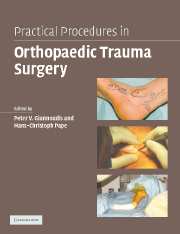Book contents
- Frontmatter
- Dedication
- Contents
- List of contributors
- Preface
- Acknowledgments
- Part I Upper extremity
- Part II Pelvis and acetabulum
- Part III Lower extremity
- Chapter 9
- Chapter 10
- Chapter 11
- Chapter 12
- Chapter 13
- Chapter 14
- 14 Fractures of the foot
- Part IV Spine
- Part V Tendon injuries
- Part VI Compartments
- References
- Index
14 - Fractures of the foot
from Chapter 14
Published online by Cambridge University Press: 05 February 2015
- Frontmatter
- Dedication
- Contents
- List of contributors
- Preface
- Acknowledgments
- Part I Upper extremity
- Part II Pelvis and acetabulum
- Part III Lower extremity
- Chapter 9
- Chapter 10
- Chapter 11
- Chapter 12
- Chapter 13
- Chapter 14
- 14 Fractures of the foot
- Part IV Spine
- Part V Tendon injuries
- Part VI Compartments
- References
- Index
Summary
OPEN REDUCTION AND INTERNAL SCREW FIXATION FOR TALAR NECK FRACTURES
Indications
Open reduction and internal screw fixation (ORIF) is used to stabilize a displaced talar neck fracture (Fig. 14.1).
Pre-operative planning
Clinical assessment
Swelling, neurovascular status, stability.
Be aware of compartment syndrome (see below). If suspicion for compartment syndrome exists, pressure measurement should be performed (for example with the IntracompartmentalPermanentPressureMonitoring System, StrykerTM Corporation, Santa Clara, CA, USA). Fasciotomy is indicated, if there is a difference of less than 30mmHg between diastolic blood pressure and compartment pressure.
Be aware of associated fractures in the adjacent foot and ankle (Fig. 14.1a,b).
Radiological assessment
Three standard views:
Mortise view of the ankle (20° internal rotation).
True lateral ankle view.
Anteroposterior (AP) view of the talar neck and head (15° internal foot rotation, 15° caudo-cranial X-ray angle); Canale view.
CT Scan.
Classification
Talar neck fractures are classifed according toHawkins, and Canale and Kelly (who added Type IV, Fig. 14.2).
Operative treatment
Anaesthesia
Regional (spinal/epidural/popliteal) or general anaesthesia.
Prophylactic antibiotics as per local hospital protocol (e.g. 3rd generation cephalosporin).
Table and equipment
3.5 mm standard cortical and cancellous screws, steel or titanium alloy.
Standard osteosynthesis set as per local hospital protocol.
A radiolucent table.
An image intensifier and a competent radiographer.
Table set up
The instrumentation set is at the foot end of the table.
Image intensifier is from the contralateral side.
- Type
- Chapter
- Information
- Practical Procedures in Orthopaedic Trauma Surgery , pp. 254 - 266Publisher: Cambridge University PressPrint publication year: 2006



